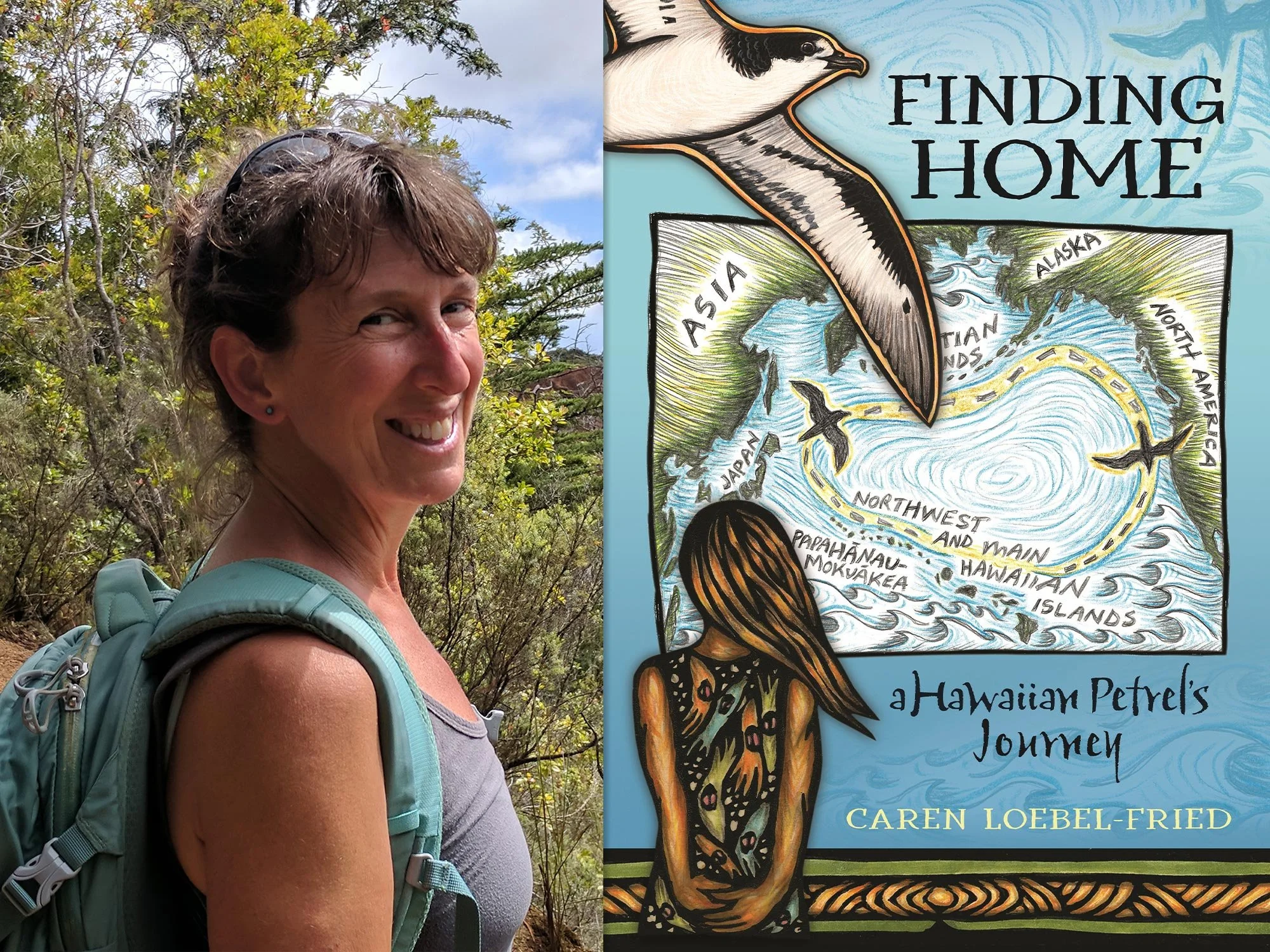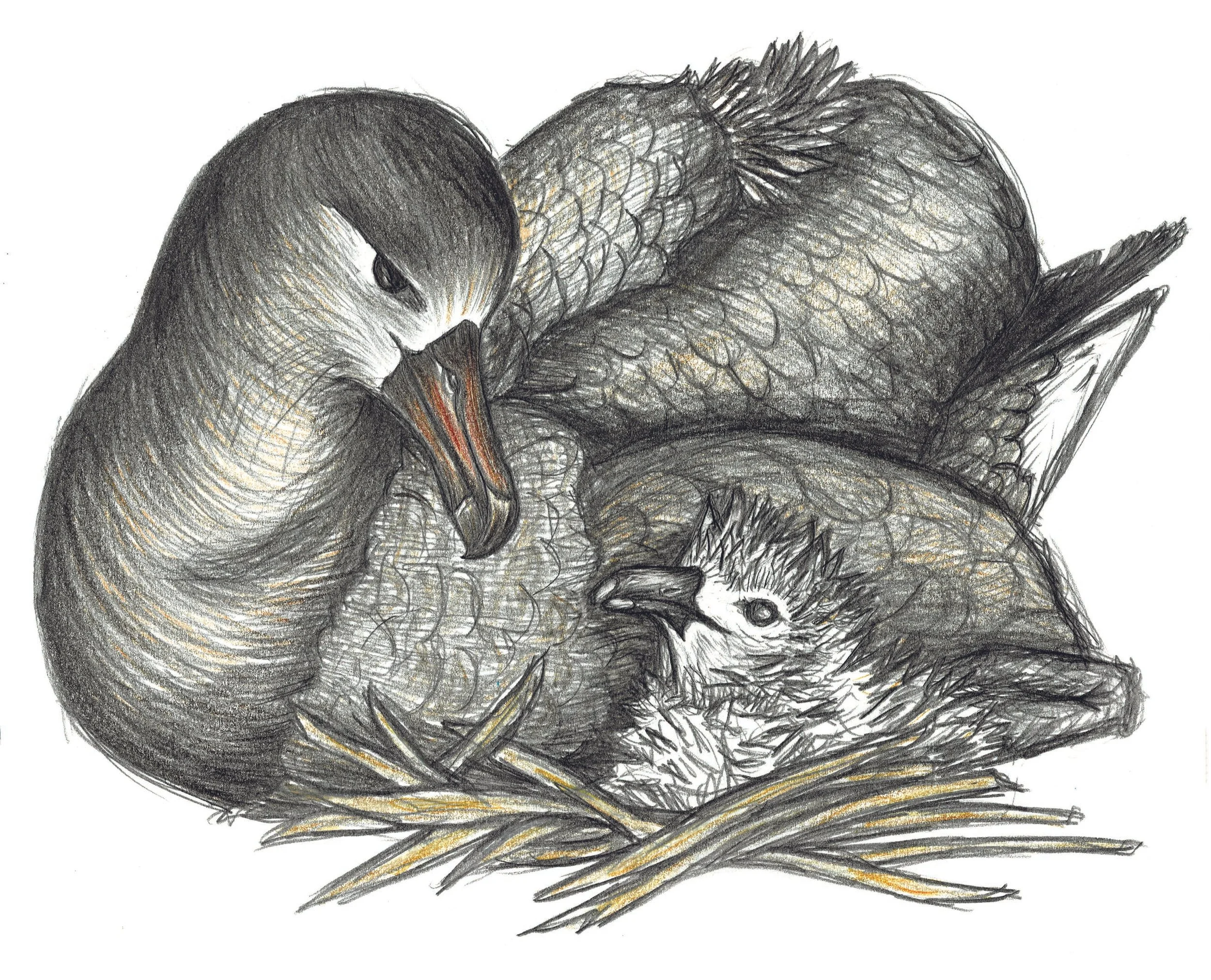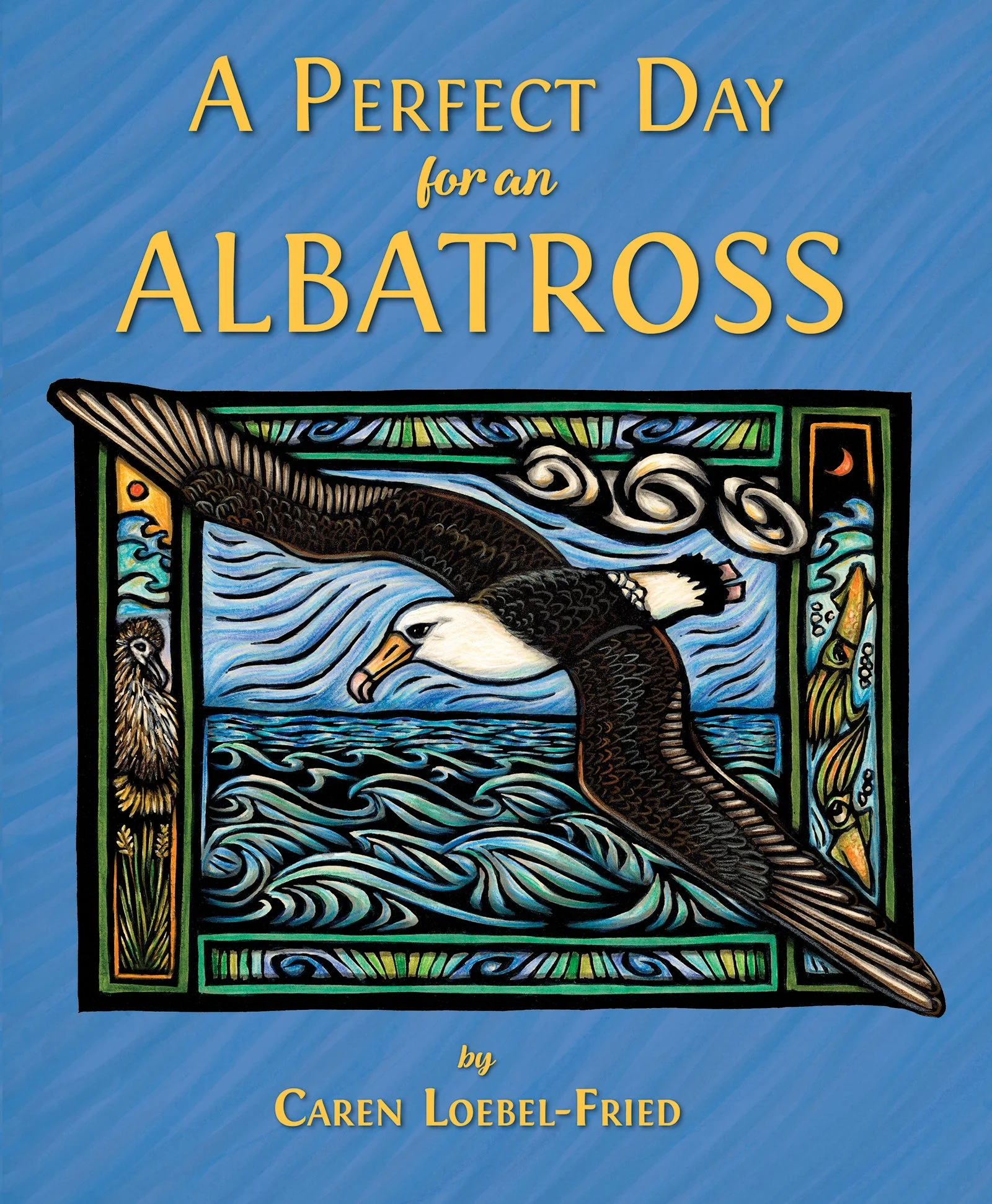Carving for Critters: Artist Caren Loebel-Fried Protects Hawaiian Places
By Safina Center Conservationist-in-Residence Hob Osterlund
Artist Caren Loebel-Fried and her upcoming book Finding Home: a Hawaiian Petrel’s Journey. ©Caren Loebel-Fried
Caren Loebel-Fried is an artist and author who lives in Volcano, Hawaiʻi. Many years ago she learned the ancient art of block printing from her mother, and now uses her talents for conservation in the Hawaiian Archipelago. Here she describes her work and her inspirations (including Carl Safina) in an interview with Hob Osterlund, Safina Center Conservationist-in-Residence.
Hob Osterlund:
Aloha, Caren. Your new book Finding Home: A Hawaiian Petrel’s Journey looks fantastic. Sounds like you had an incredible time just familiarizing yourself with these elusive birds.
Caren Loebel-Fried:
Many thanks, Hob. `Ua`u (Hawaiian petrels) spend most of their lives at sea but come to land to nest. Their Hawaiian name mimics their calls: “oo-WAH-oo”. Legends say there were once so many `ua`u in Hawai’i, they darkened the skies. I have experienced this with the Bonin petrels on Midway Atoll National Wildlife Refuge, and it is a marvel to behold. For millions of years before humans arrived in Hawai`i, `ua`u nested all the way from the coast to the mountains, nourishing the land with their guano and helping Hawai`i to be green and fertile. But waves of humans brought many challenges. `Ua`u nearly disappeared altogether, largely due to predation by cats and destruction of their nesting sites. Lately, though, some amazing humans are helping them make a comeback.
When my friend Megan Dalton was working for Pacific Rim Conservation on their seabird translocation project at Kilauea Point National Wildlife Refuge, she invited me to help with care of the adorable fluffy Hawaiian petrel chicks. At Nihoku inside the refuge, PRC had built a predator exclusion fence, installed artificial burrows, and brought `ua`u from their mountain burrows before they could be decimated by cats. The goal was for the chicks to return as adults and ultimately nest at Nihoku. I fell in love with them. I returned year after year and experienced many aspects of the translocation project and the petrel lifecycle. I also spent time with other like-minded folks on Hawai`i Island, Lana`i, and Maui. What a thrill it was to lay on springy `uluhe in Lana`ihale at night and watch the magical sky dances of courting `ua`u through infrared binoculars, and to feel the ground beneath me hum with `ua`u murmuring to one another. For several seasons I was helicoptered high up Mauna Loa on Hawai`i Island to camp inside a fenced area built to protect a remnant nesting colony. During one survey, a detector dog and his trainer joined us. We watched with wonder as he expertly sniffed out previously unknown `ua`u burrows.
Ua`u live long lives and spend several years at sea before returning to their natal nests. They are known to mate for life, so choosing the right partner is vital. The timing was magical when, during my final manuscript pass, I was able to add an epilogue about the first adult `ua`u to return to Nihoku to nest in one of the artificial burrows, and to successfully fledge a chick.
I wanted to make Finding Home a bit like a field journal, so I created lots of drawings to complement the 16 full color block prints. The book is 120 pages with nearly 100 illustrations. I also included extensive information about biology, Hawaiian culture, maps, Hawaiian and English glossaries, and ways to help seabirds.
Black-footed albatross with chick. ©Caren Loebel-Fried
HO:
The medium for most of your art is block printing, which I understand you learned from your mother. How did she learn it, and how has your work evolved from hers?
CLF:
My mom was a public school art teacher who taught herself block printing through experimentation. After I was born, she did her own work from our home. I think I absorbed so much from watching her carve and print. It became deeply ingrained in me. My own high school art teacher was a former student of my mom’s, and a wonderful block-print artist as well, so I started working with block printing in earnest. After moving to Hawai`i I started writing and illustrating books. It worked well for me as a medium for retelling legends, and helped to make natural history stories come alive.





HO:
All your work emphasizes natural history, conservation and Hawaiian culture. How did those areas become your primary focus?
CLF:
I have always loved birds and been most comfortable outside in natural settings. As I grew, I woke up to the human disconnect from—and destruction of—nature. At the same time, I became interested in art as a way of telling stories about nature. I thought representing animals as unique individuals would evoke readers’ compassion. I saw the potential to use my art to influence people of all ages towards conservation.
HO:
You have made several visits to Kuaihelani (Midway Atoll), as part of the annual albatross census and as an artist. It’s such an other-worldly place. Tell us about your work there, and how Kuaihelani and the birds influence what you do.
CLF:
It was after reading Carl Safina’s book Eye of the Albatross that I first became obsessed with mōlī. I wanted to find a way to experience them in person and was able to volunteer with the US Fish and Wildlife Service on Midway Atoll, where most of the world’s Laysan albatross nest, not to mention many black-footed albatross and a few short-tailed albatross as well. I created a piece of art for USFWS which told the story of Midway Atoll, and it was used to raise funds for conservation projects there. I also participated in the albatross census. That year we counted over 550,000 active albatross nests. Being among millions of wild birds deeply affected me, and learning more about the challenges they face made me want to help them. With Cornell Lab Publishing Group I wrote and illustrated A Perfect Day for an Albatross for young people. I ended up returning several times to Midway to volunteer with the count, and I now help lead the census on alternating years. I would say that all of my work and interest in trying to help wildlife has grown from that experience.
I also created several educational videos about albatross on Midway Atoll at: http://www.youtube.com/@carenloebel-fried8502
HO:
A number of the native critters featured in your books are endangered; some are extinct or nearly so. It seems we all need some alchemy of faith and courage in order to come face-to-face with these losses, and to live with grief. What keeps you strong and returning to tell their stories again and again?
CLF:
It is overwhelming to think about animals going extinct because of human actions. I feel such sadness, guilt, helplessness and despair. My way of dealing with it is to do what I can to help. Through my books and art, I’m hoping to help people, especially young people, to fall in love with wildlife, and try to inspire and empower them, give them knowledge and tools, to be part of the solutions. I try to be both real and hopeful. I try to make books that are fun to read and useful to educators and parents. I also feel that it's my kuleana (responsibility) to shine a light on critters who need our help and are rarely seen. Most seabirds are especially hidden from us. They come to land to meet a mate and to nest, their colonies are usually in very remote places, and many species are active only at night. I aim to make these species more familiar to people and hope to inspire a need to help them. We can all make a difference for wildlife.
HO:
You write stories for children as well as for adults. What are your primary considerations when choosing one or the other, and where do you see your work headed next?
CLF:
First I get interested in a species and start writing. The book naturally takes on its own form, either more complicated and suited for adults, or simpler and best for children. I'm currently interested in exploring a specific place where several habitats occur, learning about the different bird species the place supports, and making an illustrated bird book specifically for adults. But I never know where life will take me and what species will grab my attention and my heart.
HO:
Where can folks find your books and art?
CLF:
If readers are in Hawai’i, my books, art, and cards are available at many book shops and art galleries. All art is available as museum quality fine art giclee prints and hand-pulled block prints. For information about purchasing online, folks can visit my website, where they can also download free educational guides for some of my books: https://www.carenloebelfried.com/



